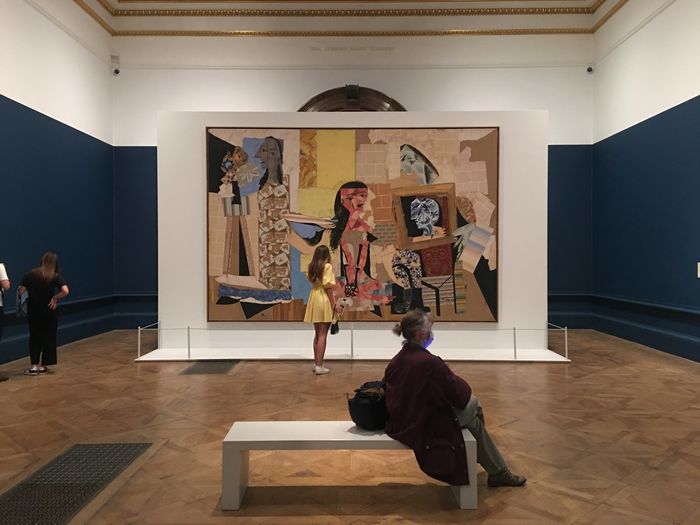Commercialism and the art world
Contrasting the lives of artists Mark Rothko and Jeff Koons, Amber Nip explores the costs of monetising contemporary art.
In an increasingly capital-driven and consumer-based society, contemporary art and money undoubtedly go hand in hand. The art world cannot function without the buying and selling of commerce, yet paradoxically this same transaction dilutes the quality and intention of both the viewer and the artist. By exploring a striking contrast between two artists, Mark Rothko and Jeff Koon (the former rejecting a commission at the Four Seasons restaurant in New York, the latter enjoying vast financial success), it becomes clear that we must reconsider the pervasive influence of commercialism over our perception of art.
“In Rothko’s mind, willingly placing his murals within the capitalist web for profit would essentially reduce his work to decoration.”
In 1958, Rothko was commissioned to paint the Seagram Murals for the Four Seasons, a prestigious restaurant and beacon to the capitalist world. Despite having by then adopted an openly Marxist and anti-capitalist stance, Rothko began working on the commission, which was his first and quite remarkable for an abstract artist. The seven murals he began composing adopted a much darker and intensified colour palette than his previous works, generating a sense of depth within an otherwise one-dimensional composition.
Inspired by the enveloping quality of Michelangelo’s vestibule in the Laurentian Library in Florence, Rothko chose to dine at the Four Seasons restaurant himself; eating beside Jackson Pollock’s Blue Poles (soon to be replaced by his own artwork) proved decisive, stirring Rothko’s contempt for the American commercial sphere. Deeply concerned with the unattainable connection between the viewer and the work itself, Rothko disgustedly withdrew the paintings later that very evening, instead donating them to the Tate where they are still free to visit today.
Rothko’s famous remark that “anybody who will eat that kind of food for those kinds of prices will never look at a painting of mine” offers an interesting insight into both the financial and moral price of art. In Rothko’s mind, willingly placing his murals within the capitalist web for profit would essentially reduce his work to decoration. The Seagram Murals would not only act as a backdrop to the social elite, but would also disappear in the entanglement of commercialised artworks.
“Ironically, the hypothetical rich art collector that Koons aims to confront is very similar to the one supplying his massive paycheck.”
Fast forward to the 21st century, Jeff Koons – arguably the most financially successful living artist – is controversially aware of his own financial viability to private art collectors. Despite the overwhelming price tag of his work, Koons turns the typical artistic archetype on its head, manufacturing cheap-looking sculptures with expensive materials and distorting conventional marketing techniques. Reminiscent of Marcel Duchamp’s ‘ready-made’ philosophy, Koons also subjects quotidian objects to reinterpretation in the context of the art gallery. What critics pick out as ‘crude’ or ‘banal’ is in fact meant to challenge preconceived conceptions of valuable art from private collectors and the commercial market.
Ironically, the hypothetical rich art collector that Koons aims to confront is very similar to the one supplying his massive paycheck. For example, Koons’ work Balloon Dog (Orange) was sold for $58.4 million in 2013, making it the highest price paid at an auction for a work by a living artist at the time – a record almost doubled later in his career. As such, the high-profit artwork he produces becomes a statement of the very capitalist notions he tries to redefine, challenging the credibility of his ‘anti-consumerist’ conceptual ideas. Much like Rothko’s fear for his own murals, the artwork becomes inaccessible to anyone other than the rich collector; the high price tag makes the work so valuable that it is often abandoned in private collections, not for viewing or enjoyment, but simply waiting to be resold at a higher price. In a way, this art then becomes even less accessible than Rothko’s murals.
Whilst his work is physically unavailable to the public domain, Koons displays a catalogue of his artwork that is accessible on his website for free. This is definitely a step in the right direction, yet still lacks some connection between the viewer and artwork that Rothko strives for in his murals. Koons’s images seem heavily edited and showcased against a blank white background - detaching them from the rawness and physicality offered by a real life visit.
Money and art are indefinitely intertwined. After all, in our 21st century capitalist market, Jeff Koons is immensely successful – his highbrow audiences and the sheer scale of his work generate plenty of interest and profit. In fact, his numerous exhibitions all around the globe embody Andy Warhol’s claim that “being good in business is the most fascinating kind of art.” However, Rothko’s condemnation of the commercial factor in his own work shows there is a great potential for harm in selling art to the highest bidder. In such an expressive and evolving artistic landscape, it is crucial that we keep in mind what price we are paying for commercialisation.
 News / Uni Scout and Guide Club affirms trans inclusion 12 December 2025
News / Uni Scout and Guide Club affirms trans inclusion 12 December 2025 News / Pembroke to convert listed office building into accom9 December 2025
News / Pembroke to convert listed office building into accom9 December 2025 Features / Searching for community in queer Cambridge10 December 2025
Features / Searching for community in queer Cambridge10 December 2025 News / Uni redundancy consultation ‘falls short of legal duties’, unions say6 December 2025
News / Uni redundancy consultation ‘falls short of legal duties’, unions say6 December 2025 News / Gov declares £31m bus investment for Cambridge8 December 2025
News / Gov declares £31m bus investment for Cambridge8 December 2025









